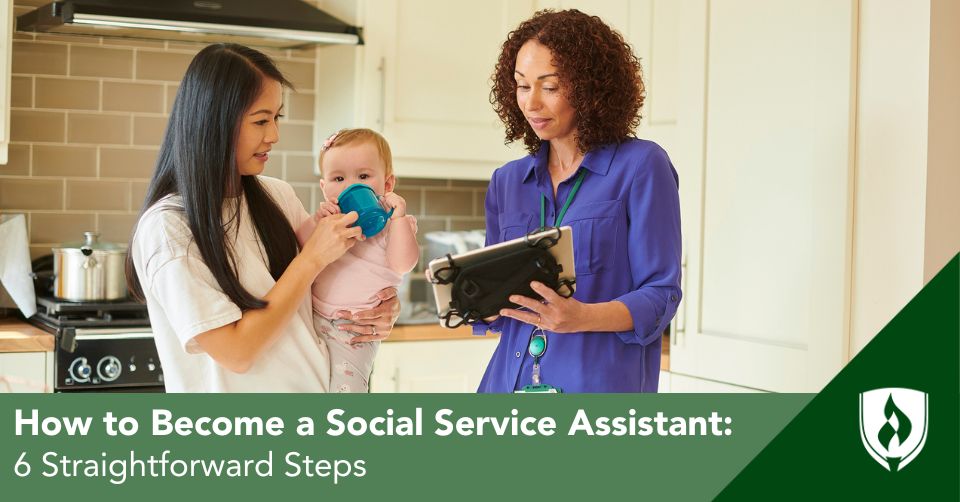
You want to help people. When you think about pursuing a new career, the idea of making a positive impact in people's lives comes to the forefront. Maybe you always thought you'd go into social or community services, but life got in the way. Or maybe you've just never had the time to commit to a bachelor's degree, let alone a master's degree or something requiring licensure.
Whatever your circumstances, becoming a social service assistant might be a more doable pathway into the field of human and social services. Working as a social service assistant is a great way to help the people most in need, without requiring years of preparation.
And it's a growing field. The employment of social and human service assistants is projected to grow 9%—a rate much faster than the average for all occupations—from 2022 to 2032, according to the U.S. Bureau of Labor Statistics.1
Here's a quick explanation of what a social service assistant does and a step-by-step guide for how you could get there.
What is a social service assistant?
Social service assistants (also referred to as human service assistants) work where people most need help. They provide client services across a variety of fields, including psychology, rehabilitation and social work, according to the BLS.1 Since this type of role has grown to cover so much ground, job titles have grown to include terminology like human service assistant, social service specialist and more.
Human service assistants work with a range of populations, including children and families, the elderly, people with disabilities, people with addictions, veterans, people with mental illnesses, immigrants, former prison inmates, people experiencing homelessness and more.1
What does a social service assistant do?
Though it depends on the individuals they serve, human service assistants typically work for nonprofit organizations, for-profit social service agencies and state and local governments. They may also work in residential care facilities, in personal care services or for family services organizations.
That might sound pretty broad and general, but the truth is that social services assistants find themselves helping people in such a huge variety of ways--based on what someone needs. Oftentimes, the people you work with in this career are facing major barriers to their safety, health and wellbeing.
In our society, people can easily fall through the cracks of education, housing, healthcare or employment. And that goes double for anyone experiencing a crisis.
If you step into this kind of role, you'll be working to help fill the gaps, to help connect the dots.
Whatever population they work with, social service assistants typically do the following on a day-to-day basis.1
- Help determine what type of aid their clients need
- Work with clients and other professionals, such as social workers, to develop a treatment plan
- Help clients find assistance with daily activities, such as eating and bathing
- Research services, such as food stamps and Medicaid, that are available to clients
- Coordinate services provided to clients
- Help clients complete paperwork to apply for assistance programs
- Help clients locate jobs, temporary or permanent housing or legal assistance
- Check in with clients to ensure that services are provided appropriately
What's the difference between a social service assistant and licensed social worker?
Social and human service assistants are not licensed social workers. Instead, they often work under the direction or supervision of one. A licensed social worker is a specially-trained social worker who has met specific requirements for licensure, whereas a social service assistant is a non-licensed role with lower education requirements.
Please note, Rasmussen University’s Human Services Associate’s and Human Services Bachelor’s degree programs are not designed to meet, and do not meet, the educational requirements for professional licensure as a therapist, counselor, social workers, psychologist, or other similar licensed careers in any state. For further information on professional licensing requirements, please contact the appropriate board or agency in your state of residence.
But if you are interested in roles like social services assistant, the human services program at Rasmussen could be a good first step for you.
6 steps to becoming a social service assistant
Roles like these are not for the faint of heart. Social and human services can see people at their worst, their most frightened or most desperate moments. Social service assistants need a foundational knowledge in social and behavioral sciences to help them respond with professionalism, empathy and readiness to help.
That starts with education.
1. Pursue a human services associate's degree
The requirements for social and human service assistants vary, although candidates typically have at least a high school diploma and complete certain on-the-job training. To be more prepared and competitive in the job market, many aspiring social service assistants will choose to obtain a Human Services Associate's Degree.
In order to do this, there are a couple things to consider.
Check the program entrance requirements
Regardless of the program you choose, applying to and enrolling in an associate's degree program will take a bit pf planning. Make sure you contact an admissions advisor to learn about things like immunizations, background checks and anything else that may be required by the school you are considering.
For example, for Rasmussen Associate’s Human Services degree program, applicants must have graduated from high school or completing a high school education in a homeschool setting approved under state law or if state law does not require a homeschooled student to obtain a completion credential-completing a high school education in a homeschool setting that qualifies as an exemption from compulsory attendance requirements under state law or a state-recognized equivalent such as a General Education Development (GED) certificate.
Contact the programs to ask specific financial questions
Finances are one of the biggest reasons that prospective students avoid higher education. But it might be a manageable investment.
The best way to figure this out is to contact any program you are considering directly. Fill out a request more information form or call an admissions advisor. This will give you better information about options like self-directed assessments,2 credits for prior learning, loans and grants for those who qualify, outside scholarship opportunities, corporate grants and military grants for those who qualify.
It will also help you get a feel for the program and find out if the university will meet your needs.
Find a program schedule that works for you
Of course, you can only commit to a program with a schedule that works for you.
Look for options that meet your specific needs—whether that's something part-time, full-time, in-person or online. Rasmussen University’s Human Services associate’s and Human Services bachelor’s degree programs are only offered entirely online.
Plus, think about the overall time commitment from the program start to completion. As an example, the Rasmussen University Human Services Associate's Degree can be completed in as few as 18 months.3
2. Complete the required coursework
Completing the coursework isn't just a means to getting a certificate or degree, it's where you'll learn the information you need to work day in and day out as an effective professional in the field. Each class is geared toward helping you meet that ultimate goal. Here are a few sample course descriptions to give you an idea of what you'll learn.
Evolving Populations in Human Services
Learn all about the different populations human services professionals work with, some of the different settings they work in and the different types of positions they can hold.
Working with Clients
Get an introduction to the communication techniques and practical skills used in a human services profession. Become familiar with the typical job description and daily activities of a human services professional, and begin to practice and develop your own communication tools to use in the field.
Perspectives on Human Behavior
Study human behavior the individual, group and societal level. Explore different theories and knowledge related to the many biological, psychological, sociological and cultural characteristics of society.
3. Gain the necessary skills
Course credits and grades are important, but so are the less tangible skills you'll learn along the way.
Here are a few skills you'll gain through your program curriculum that are integral to being an effective social service assistant, and will come in handy for the rest of your life.
Interpersonal skills and working with others
From regular self-reflection activities to relationship management techniques, you'll gain the tools you need to get to know yourself better and also be more effective in working with others.
Diversity awareness
Learn about issues relevant to your local community and reflect on different community needs and resources, including systems that support diverse populations.
Crisis response strategies
Become familiar with how to respond to crisis situations including stress, assault, substance abuse and loss. You'll also gain an understanding of the roles of—and the relationships between—victims, police officers, nurses and counselors.
Electronic communication and case management
Become proficient in different computer applications as well as how to manage client caseloads, document casework and electronic health records. You'll also learn how to responsibly communicate with clients through various telehealth and social media channels.
4. Update your resume and career materials
Once you've completed your program and gained all the necessary skills and knowledge, it's time to show off your achievements. Updating your resume, LinkedIn profile, cover letters and other career materials with your accomplishments is an essential next step.
Add your associate's degree to the education section of your resume as well as an overview of your newfound skills and knowledge. Learning how to communicate the value of your experience, as well as describing your background and qualifications to others can go a long way in professional networking and interview settings.
5. Start your job search
As you put your career materials to work and begin searching for and interviewing for jobs, keep in mind that social and human service assistants have many job titles.
In addition to the straightforward "social service assistant" title, the career may also be referred to as any of the following in a job posting, so don't limit your search by forgetting to keep an eye out for these additional titles.
- Community Service Assistant
- Advocate
- Program Assistant
- Human service worker
6. Consider further education
You're already a social service assistant, but if obtaining your Associate's degree and working in the human services field encourages you to go even further, you may be in a position to pursue a Human Services Bachelor's Degree program.
This is a pathway you could choose in the future if you decide you’d like to continue your education down the line--and your credits from your Associate’s degree might help you with your Bachelor’s degree program.
Take the first step
Getting to step 6 all starts with step 1: Pursuing an associate's degree to introduce you to the human services field. Learn more about the Rasmussen University's Human Services Associate's Degree program.
Rasmussen University’s Human Services Associate’s degree and Human Services Bachelor’s degree programs are not designed to meet, and do not meet, the educational requirements for professional licensure as a therapist, counselor, social worker, psychologist, or other similar licensed careers, in any state. Rasmussen University’s Human Services Associate’s degree and Human Services Bachelor’s degree programs have not been approved by any state professional licensing body, and these programs are not intended to lead to any state-issued professional license. For further information on professional licensing requirements, please contact the appropriate board or agency in your state of residence.
1Bureau of Labor Statistics, U.S. Department of Labor, Occupational Outlook Handbook, Social and Human Services Assistants, (accessed May 2024), U.S. Bureau of Labor Statistics (bls.gov).
2Rasmussen University’s self-directed assessment offerings fulfill some academic program requirements. Demonstrated mastery through the successful completion of online self-directed assessments allows students to test out of some courses. The number of self-directed assessments and programs that offer the self-directed option varies. Please check with the current Rasmussen Catalog and Student Handbook for specific details: https://www.rasmussen.edu/degrees/course-catalog/
3Completion time is dependent on transfer credits accepted and the number of courses completed each term.




